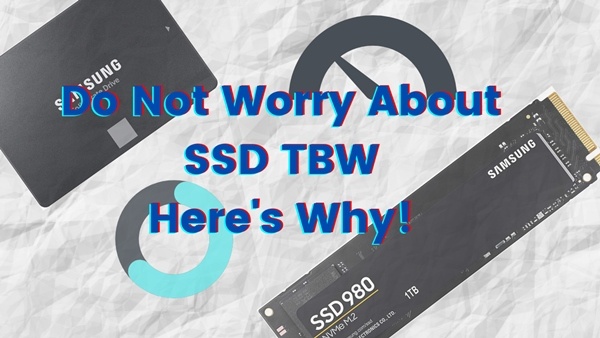Once and finally, I am going to tell you what happens after your SSDs TBW limit reaches. Why I am talking about it because most of the users are confused about the TBW. It is normal to get worried about anything where certain limits in numbers are given to you.
So I want to tell you that the thing as a life of SSD, Warranty period and TBW (Terabytes Written) we get along with your SSDs, you should not worry about all these things. I am telling this by my experience of using SSDs for years. And I can say if you have a good SSD and you are using it even under very tough environments, you would have no issues at all.
Until and Unless and forcefully you want to cross that limit and you want to full it by writing data constantly, that is another thing. Suppose you are regularly using and writing normal data even on a regular basis, then you never cross the data limit.

How to calculate the total daily SSD write limits by its TBW?
Suppose you buy an SSD with 250 GB storage capacity and it has a TBW value of 100. It means you can write a total of 102400 GB (Binary) data on your SSD.
Now, if we make a calculation to get the daily limit, it would look something like this:
100TBW (102400GB) / 365 Days = 280 GB/Day For a Year
You can see that your SSD with 250GB with 100 TBW can easily read around 280GB of data per day on it. But, no SSD comes with one year warranty. Most of them will have a limited 3-Years warranty. Suppose, your SSD also has a 3-Years Warranty.
100 TBW (102400GB) / (365×3=1095 Days) = 93GB/Day for three years
Formula to calculate the total data written per day.
In simple words, you 250GB SSD can write around 90GB per day on it if it has a 3-Years Warranty and 100TBW limit. If your one has different numbers, you can easily calculate your limits using the same method.
Keep a note that this is a calculation to have an idea of our daily writing limits. It means that you can write more than 93 GB of data in a day. It’s like withdraw some amount (write-data) from your bank (TBW). Now, it’s up to you whether you are taking it daily or all at once.
SSD Endurance Calculation Formulas
Here are some of the most used formulas to calculate TBW, DWPD, GB/Day, PBW, and various other things.
DWPD = GB/day ÷ S
GB/day = DWPD × S
GB/day = (TBW(TB) × 1000) ÷ (T × 365)
DWPD = (TBW(TB) × 1000) ÷ (S × T × 365)
TBW(TB) = (GB/day × T × 365) ÷ 1000
TBW(TB) = (DWPD × S × T × 365) ÷ 1000
PBW = TBW(PB) = TBW(TB) ÷ 1000
What happens when you cross the TBW limit of your SSD?
A lot of people think that their SSD will go dead once they reach the total TBW limit. They think that after TBW fulls, the SSD won’t be of any use to them. But, that is totally a misconception. After you spend all your TBW limits, the SSD will keep its data and you can read it anytime you want. But, the writing functions will not be available anymore.
The things we listen to, the Mean Time Between Failure (MTBF), Total Terabyte Write (TBW) and all this is estimated data. These numbers are to tell you that the NAND cells are having limited writing capacity.
However, it is very common to see various SSDs going beyond these limits. People who are using their SSDs for years generally cross these limits. In some cases, the SSDs may stop writing before the limit crosses or sometimes before that time. But, this will happen after many years. I know people who are using their SSDs for 5 to 10 years and they are working perfectly fine.
How much TBW you can actually consume?
Even if your work includes heavy data reading and writing, it is tough to write around 100GB on a daily basis. Someday, you might write that data, but it is not possible to do it daily. However, I know some people who are doing this thing. They are literally writing more than 50GB data on their SSDs and then removing it. Some jobs need this kind of work. These works may include automatic data transfers, internet downloading, etc
I am just telling you an example. I want to tell you that you should know your consumption. If you are going to play games, surf the internet, type texts, create graphics, write blogs, edit videos, and do various works like this, you will hardly write 1 GB within a day. So, if you are really writing just 1GB data per day, imagine how would you reach that 90GB/day limit. It’s nearly impossible. This is why I am telling you not to worry about the TBW.
Final Words
I have already published another article related to this topic. You can read it as well. Again, I don’t think that a normal consumer can use this huge amount of data daily. So you do not need to worry. This is the reason why this is going to be the last article related to the TBW. If you have bought it, just use it freely even if has 100TBW (which is a normal number to see).
Or, if you are about to buy an SSD, just go for a higher TBW limit if your budget allows it. Otherwise, you are good to do with low TBW limits as well. SSDs are becoming more and more powerful and reliable at the same time.
Thanks for reading!